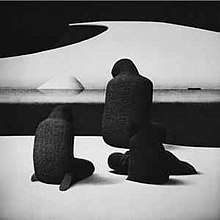Radiance and Submission
Radiance and Submission is the third studio album of Canadian electronic musician Michael Silver, known by his stage name as CFCF. Silver was inspired to make Radiance and Submission from his purchase of an acoustic guitar. Therefore, the LP involves numerous guitar melodies and harmonies playing at the same time. It was released on July 31, 2015 by the label Driftless Recordings and was Silver's first Billboard entry, peaking at number eight on the magazine's American New Age Albums chart. Radiance and Submission garnered a mixed critical reception upon its distribution.
| Radiance and Submission | ||||
|---|---|---|---|---|
 | ||||
| Studio album by | ||||
| Released | July 31, 2015 | |||
| Recorded | 2013–14 | |||
| Genre | ||||
| Length | 34:18 | |||
| Label | Driftless Recordings | |||
| Producer | Michael Silver | |||
| CFCF chronology | ||||
| ||||
| Singles from Radiance and Submission | ||||
Recording and concept


Radiance and Submission was recorded in the winter of 2013 to 2014.[1] The album deals with themes of isolation, which, according to Ian King of The Line of Best Fit, may have been a result from how Silver felt when he produced the album in the winter.[1] For the album, Silver went for a record that represented a paradox of “non-time, non-being, non-death.”[8] As a Spectrum Culture critic analyzed the music's relationship with Matsuda Matsuo's cover art for Radiance and Submission, "[the artwork consists of] a cold scene, a family of sorts, kneeling, seeming to mourn the death of a unknown figure, beside a conceptual lake or seaside, [and] the long echoy synth-leads call upon an open space and [are] almost animalistic in its tone and flavor."[8]
The names of the tracks on Radiance and Submission are based on the titles of Japanese writings and the films of German filmmaker Werner Herzog.[1] The title of “In Praise of Shadows” is also the name of Jun'ichirō Tanizaki's essay about Japanese aesthetics, the name of “The Ruined Map” is the title of a 1967 book by Kōbō Abe, and "La Soufrière" is titled after Herzog's 1977 documentary about an erupting volcano.[1] Herzog previously had a major influence on Silver's music when he recorded his EP The River (2010), which was based on Herzog's Fitzcarraldo (1982).[1]
Composition
Radiance and Submission is mostly an instrumental record, exceptions being the tracks "The Ruined Map" and "La Soufriere" which feature vocal performances from Silver.[9] Silver categorized Radiance and Submission as a hybrid of folk, classical, modern pop music, and chamber jazz.[10] The music mainly consists of numerous acoustic guitar melodies and harmonies being performed simultaneously;[11] Silver was inspired to make an album of this style after he purchased a guitar, and he listened to the improvisational guitar works of Pat Metheny, Terry Callier, and Terje Rypdal while producing Radiance and Submission.[1][11] The album includes a mixture of both digital and acoustic sounds that have an "even struggle for dominance throughout," wrote Craig Clemens of Spectrum Culture.[8]
A review by Justin Pearson published in Soundblab described Radiance and Submission as "less of a background and more of a backdrop. Instead of fading into your surroundings, it augments them in the manner of a curtain, closing off all the unnecessary aspects to shine a light on the now. It brings into focus whatever your current surroundings are and stages that location, whether physically or emotionally."[9] Radiance and Submission has a much more minimal structure than CFCF's previous album Outside (2013), where "even in busier moments, there is sufficient enough breathing room to catch each sound and instrument’s subtle exhalations," wrote King.[1] King also described it as somewhere between CFCF's extended plays Exercises (2012), a record where each song sounded the same, and Music for Objects (2013), where all of its tracks sound very disparate from each other: "Each song [on Radiance and Submission] sets out to achieve something apart from the others, but the motion between them is often fluid."[1]
Critical reception
| Aggregate scores | |
|---|---|
| Source | Rating |
| AnyDecentMusic? | 6.1/10[12] |
| Metacritic | 67/100[13] |
| Review scores | |
| Source | Rating |
| Consequence of Sound | C+[2] |
| Exclaim! | 6/10[14] |
| In Your Speakers | 63/100[4] |
| The Line of Best Fit | 7.5/10[1] |
| Now | |
| Pitchfork | 6.9/10[3] |
| Soundblab | 7/10[9] |
| Spectrum Culture | |
| State | |
Pearson, in a favorable review of Radiance and Submission, opined, "Radiance and Submission plays out like a collection of inward-seeking moments that serves to highlight those pure, specific feelings of time and place - the ones unbothered by intrusion from the outside."[9] Clemens enjoyed the album as being the most "complex" from other new age music, highlighting the record's "compositional techniques, such as his ability to develop and articulate counter-point and his ability to set a scene with nothing more than well-constructed sound to get his point across."[8] However, he also opined that the short length of each track was a major drawback of the record: "Silver has spent so much time and effort to build a song up to this great climax, but then just gives up."[8] Pitchfork's Clayton Purdom was another critic that highlighted the album's compositional methods, more specifically its use of "interstitial moments:" "The establishing shots and denouements of his compositions are here turned into the raw material for something strange and fascinating and (for him, at least) new."[3]
Journalist Benjamin Boles gave the album a score of a three out of five, calling its first half the "weakest" part and the rest of the record the most "interesting," where "Silver's soft vocals begin to give the songs a sharper focus and a human vulnerability."[15] Ali Van Houten of In Your Speakers wrote that while Radiance and Submission was decent, it wasn't worth more than one listen, reasoning that it "gets bogged down in the territory of aimless ambience."[4] Similarly, James Glynn of State magazine labeled the album as a "lovely, yet largely unexciting listen" and "a triumph of elegance over endeavour."[16] He explained that, despite its "crisp production," "tranquil composition," and "intriguing musical variations," it "lacks spice."[16] A reviewer for the webzine Treble, however, was much harsher on the album's contrived and aimless quality, calling it "unacceptable" given Silver's past experiences of experimenting with styles that were more "loud and even scary."[17] Some reviewers criticized the album's combination of acoustic folk and electronic music.[2][14] Writer Matthew Sedacca found it to be "finicky," stating that "Silver attempts to force stylistic egalitarianism, the two sides of his composition awkwardly failing to join."[2] An Exclaim! journalist opined than the album was a "stunningly simple, meditative listen" for only "a handful of moments," writing that "the Montreal musician attempts a serene matrimony of the two musical sides that struggles to strike a balance between stimulating and stale when it comes to the record's overarching sound."[14]
Track listing
Source: [18]
All songs written and produced by Michael Silver.
| No. | Title | Length |
|---|---|---|
| 1. | "In Praise Of Shadows" | 4:07 |
| 2. | "Sculptures Of Sand" | 3:43 |
| 3. | "A Various Language (From The Same Hill)" | 3:54 |
| 4. | "Tethered In Dark" | 6:56 |
| 5. | "The Ruined Map" | 2:58 |
| 6. | "Blanketed In Snow A Place Returned" | 3:50 |
| 7. | "La Soufrière" | 3:15 |
| 8. | "Two Mirrors" | 5:35 |
| Total length: | 34:18 | |
- Sample credits
- "A Various Language (From The Same Hill)" is adapted from the piece "From The Same Hill" by Brian Eno.[18]
Release history
| Region | Date | Format(s) | Label |
|---|---|---|---|
| Worldwide[6] | July 31, 2015 | Driftless Recordings |
Charts
| Chart (2015) | Peak position |
|---|---|
| US New Age Albums (Billboard)[19] | 8 |
References
- King, Ian (July 24, 2015). "Radiance and Submission by CFCF". The Line of Best Fit. Retrieved September 30, 2017.
- Sedacca, Matthew (July 23, 2015). "CFCF – Radiance and Submission". Consequence of Sound. Retrieved September 30, 2017.
- Purdom, Clayton (23 July 2015). "CFCF: Radiance and Submission". Pitchfork. Conde Nast. Retrieved September 30, 2017.
- Van Houten, Ali (July 31, 2015). "CFCF: Radiance and Submission". In Your Speakers. Retrieved September 30, 2017.
- Sherburne, Philip (August 25, 2015). "The Tide Is High: 10 Records from the Balearic Revival". Pitchfork. Conde Nast. Retrieved October 8, 2017.
- Hughes, Josiah (June 4, 2015). "CFCF "The Ruined Map"". Exclaim!. Retrieved October 7, 2017.
- "CFCF – La Soufrière". Dummy. July 16, 2015. Retrieved October 7, 2017.
- Clemens, Craig (10 September 2015). "CFCF: Radiance and Submission". Spectrum Culture. Retrieved September 30, 2017.
- Pearson, Justin (29 July 2015). "CFCF – Radiance and Submission". Soundblab. Retrieved September 30, 2017.
- Reynaldo, Shawn (February 29, 2016). "CFCF: Painfully sincere". Resident Advisor. Retrieved June 3, 2017.
- M. Preister, Alec (February 9, 2016). "The Remix Grammy: For the Art and Science of the Musical Cocktail". The New York Times. The New York Times Company. Retrieved June 2, 2017.
- "Radiance And Submission by CFCF". AnyDecentMusic? Retrieved 30 September 2017.
- "Reviews and Tracks for Radiance And Submissionby CFCF". Metacritic. CBS Interactive. Retrieved 30 September 2017.
- Slingerland, Calum (July 29, 2015). "CFCF Radiance and Submission". Exclaim!. Retrieved September 30, 2017.
- Boles, Benjamin (July 29, 2015). "CFCF". Now. Now Communications. Retrieved September 30, 2017.
- Glynn, James (31 July 2015). "CFCF – Radiance and Submission". State. Retrieved September 30, 2017.
- Blyweiss, Adam (September 4, 2015). "CFCF : Radiance and Submission". Treble. Retrieved October 10, 2017.
- Radiance & Submission (2015). CFCF. Driftless Recordings. DFS012.
- "CFCF Radiance & Submission Chart History". Billboard. Prometheus Global Media. October 8, 2017.